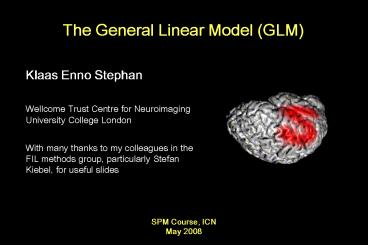The General Linear Model (GLM) - PowerPoint PPT Presentation
1 / 27
Title:
The General Linear Model (GLM)
Description:
With many thanks to my colleagues in the FIL methods group, particularly Stefan ... Convolve stimulus function with a canonical hemodynamic response function (HRF) ... – PowerPoint PPT presentation
Number of Views:502
Avg rating:3.0/5.0
Title: The General Linear Model (GLM)
1
The General Linear Model (GLM)
- Klaas Enno Stephan
- Wellcome Trust Centre for Neuroimaging
- University College London
- With many thanks to my colleagues in the FIL
methods group, particularly Stefan Kiebel, for
useful slides
SPM Course, ICNMay 2008
2
Overview of SPM
Statistical parametric map (SPM)
Design matrix
Image time-series
Kernel
Realignment
Smoothing
General linear model
Gaussian field theory
Statistical inference
Normalisation
p lt0.05
Template
Parameter estimates
3
A very simple fMRI experiment
One session
Passive word listening versus rest
7 cycles of rest and listening
Blocks of 6 scans with 7 sec TR
Stimulus function
Question Is there a change in the BOLD response
between listening and rest?
4
Modelling the measured data
Make inferences about effects of interest
Why?
- Decompose data into effects and error
- Form statistic using estimates of effects and
error
How?
stimulus function
effects estimate
linear model
statistic
data
error estimate
5
Voxel-wise time series analysis
Time
Time
BOLD signal
single voxel time series
SPM
6
Single voxel regression model
error
??1
?2
Time
e
x1
x2
BOLD signal
7
Mass-univariate analysis voxel-wise GLM
y
- Model is specified by
- Design matrix X
- Assumptions about e
N number of scans p number of regressors
The design matrix embodies all available
knowledge about experimentally controlled factors
and potential confounds.
8
GLM assumes Gaussian spherical (i.i.d.) errors
sphericity iiderror covariance is scalar
multiple of identity matrix Cov(e) ?2I
Examples for non-sphericity
non-identity
non-identity
non-independence
9
Parameter estimation
y
X
Least squares parameter estimate (assuming iid
error)
10
A geometric perspective
y
e
Design space defined by X
x2
x1
11
What are the problems of this model?
- BOLD responses have a delayed and dispersed form.
- The BOLD signal includes substantial amounts of
low-frequency noise. - The data are serially correlated (temporally
autocorrelated) ? this violates the assumptions
of the noise model in the GLM
12
Problem 1 Shape of BOLD responseSolution
Convolution model
The response of a linear time-invariant (LTI)
system is the convolution of the input with the
system's response to an impulse (delta function).
expected BOLD response input function??
impulse response function (HRF)
13
Convolution model of the BOLD response
Convolve stimulus function with a canonical
hemodynamic response function (HRF)
?? HRF
14
Problem 2 Low-frequency noise Solution High
pass filtering
S residual forming matrix of DCT set
discrete cosine transform (DCT) set
15
High pass filtering example
16
Problem 3 Serial correlations
with
1st order autoregressive process AR(1)
autocovariance function
17
Dealing with serial correlations
- Pre-colouring impose some known autocorrelation
structure on the data (filtering with matrix W)
and use Satterthwaite correction for dfs. - Pre-whitening 1. Use an enhanced noise model
with hyperparameters for multiple error
covariance components. 2. Use estimated
autocorrelation to specify filter matrix W for
whitening the data.
18
How do we define W?
- Enhanced noise model
- Remember how Gaussiansare transformed linearly
- Choose W such that error covariance becomes
spherical - Conclusion W is a function of V?? so how do we
estimate V?
19
Multiple covariance components
enhanced noise model
Q2
Q1
V
?1
?2
Estimation of hyperparameters ? with ReML
(restricted maximum likelihood).
20
Contrasts statistical parametric maps
c 1 0 0 0 0 0 0 0 0 0 0
Q activation during listening ?
Null hypothesis
21
t-statistic based on ML estimates
c 1 0 0 0 0 0 0 0 0 0 0
ReML-estimate
22
Physiological confounds
- head movements
- arterial pulsations
- breathing
- eye blinks
- adaptation affects, fatigue, fluctuations in
concentration, etc.
23
Correlated and orthogonal regressors
y
x2
x2
x1
Correlated regressors explained variance is
shared between regressors
When x2 is orthogonalized with regard to x1, only
the parameter estimate for x1 changes, not that
for x2!
24
Outlook further challenges
- correction for multiple comparisons
- variability in the HRF across voxels
- slice timing
- limitations of frequentist statistics? Bayesian
analyses - GLM ignores interactions among voxels? models of
effective connectivity
25
Correction for multiple comparisons
- Mass-univariate approach We apply the GLM to
each of a huge number of voxels (usually gt
100,000). - Threshold of plt0.05 ? more than 5000 voxels
significant by chance! - Massive problem with multiple comparisons!
- Solution Gaussian random field theory
26
Variability in the HRF
- HRF varies substantially across voxels and
subjects - For example, latency can differ by 1 second
- Solution use multiple basis functions
- See talk on event-related fMRI
27
Summary
- Mass-univariate approach same GLM for each voxel
- GLM includes all known experimental effects and
confounds - Convolution with a canonical HRF
- High-pass filtering to account for low-frequency
drifts - Estimation of multiple variance components (e.g.
to account for serial correlations) - Parametric statistics

